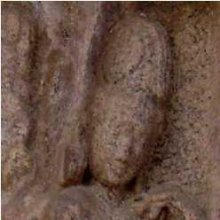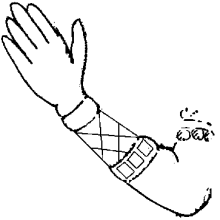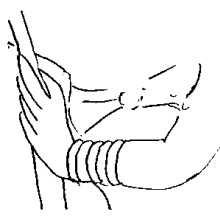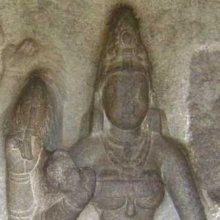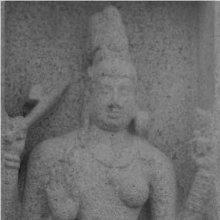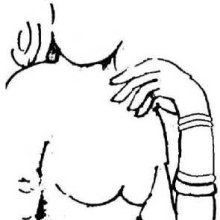Bracelet: 1 definition
Introduction:
Bracelet means something in Hinduism, Sanskrit. If you want to know the exact meaning, history, etymology or English translation of this term then check out the descriptions on this page. Add your comment or reference to a book if you want to contribute to this summary article.
Images (photo gallery)
(+17 more images available)
In Hinduism
Natyashastra (theatrics and dramaturgy)
Source: Shodhganga: Elements of Art and Architecture in the Trtiyakhanda of the Visnudharmottarapurana (natya)Bracelets were commonly used as Ornaments (in Indian Dramas) as conveyed through the Alaṃkāra division of Āhāryābhinaya: one of the four divisions of Abhinaya or “ways to convey or represent one’s emotion to others”, according to the Viṣṇudharmottarapurāṇa, an ancient Sanskrit text which (being encyclopedic in nature) deals with a variety of cultural topics such as arts, architecture, music, grammar and astronomy.—Alaṃkāra deals with the decoration of garlands and ornaments. In the Nāṭyaśāstra four kinds of ornaments and five kinds of garlands are accepted. In the Sanskrit dramas ornaments like ear-rings, bracelets, head-gears etc. are seen to be collected from nature. This is informed in many of the Sanskrit dramas.

Natyashastra (नाट्यशास्त्र, nāṭyaśāstra) refers to both the ancient Indian tradition (shastra) of performing arts, (natya—theatrics, drama, dance, music), as well as the name of a Sanskrit work dealing with these subjects. It also teaches the rules for composing Dramatic plays (nataka), construction and performance of Theater, and Poetic works (kavya).
See also (Relevant definitions)
Full-text (+515): Angada, Kankana, Keyura, Valaya, Kataka, Karabhushana, Kambu, Kudupa, Avapaka, Pariharya, Shankhaka, Citrangada, Kundala, Pratisara, Kankanin, Bajubanda, Keyurin, Suvarnakataka, Angadin, Kankanabharana.
Relevant text
Search found 134 books and stories containing Bracelet; (plurals include: Bracelets). You can also click to the full overview containing English textual excerpts. Below are direct links for the most relevant articles:
Trishashti Shalaka Purusha Caritra (by Helen M. Johnson)
List of 14 ornaments < [Notes]
Part 3: Fight with Acchadanta < [Chapter XI - burning of dvārakā and the death of kṛṣṇa]
Part 5: Conquest of the Sindhu by Sagara < [Chapter IV - Conquest of Bharatavarṣa by Sagara]
Pallava period (Social and Cultural History) (by S. Krishnamurthy)
Bracelets (b): Bracelet formed of multiple coils < [Chapter 4 - Material Culture of the People]
Bracelets (c): A circular sheet of metal with prominent rims < [Chapter 4 - Material Culture of the People]
Leg Ornaments < [Chapter 4 - Material Culture of the People]
Garga Samhita (English) (by Danavir Goswami)
Verse 2.20.33 < [Chapter 20 - The Rāsa-dance Pastime]
Verse 2.4.15 < [Chapter 4 - The Liberation of Vatsāsura]
Verse 2.8.27 < [Chapter 8 - Description of Seeing Lord Kṛṣṇa]
The Jataka tales [English], Volume 1-6 (by Robert Chalmers)
Jataka 408: Kumbhakāra-jātaka < [Volume 3]
Jataka 539: Mahājanaka-jātaka < [Volume 6]
Jataka 529: Sonaka-jātaka < [Volume 5]
Sripura (Archaeological Survey) (by Bikash Chandra Pradhan)
Stone Images (3): Vaisnava Images < [Chapter 3 - Sculptural Programme]
The Metal Art < [Chapter 3 - Sculptural Programme]
Copper Images < [Chapter 3 - Sculptural Programme]
The Skanda Purana (by G. V. Tagare)
Chapter 20 - The Great Efficacy of Rudrākṣa: The Story of Mahānandā < [Section 3 - Brāhmottara-khaṇḍa]
Chapter 37 - Importance of Offering a Bracelet (kaṅkaṇa) < [Section 1 - Prabhāsa-kṣetra-māhātmya]
Chapter 30 - Efficacy of the Worship of Someśvara < [Section 1 - Prabhāsa-kṣetra-māhātmya]
